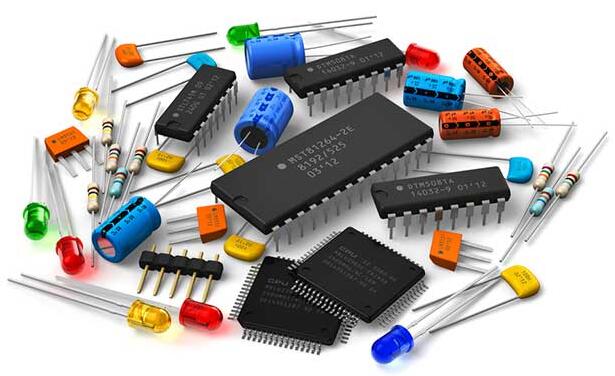Electronic components refer to the components of electronic components and small machines and instruments, which are often composed of several parts and can be used in similar products. Common electronic components include resistors, capacitors, diodes, transistors, inductors, and other devices.

Identification of components
1. Resistance
The resistance is represented by "R" and a number in the circuit, for example, "R7" represents the resistance numbered 7. The main functions of the resistance in the circuit are shunt, current limiting, voltage sharing, bias, filtering (combined with capacitors), and impedance matching.
There are two main methods for identifying resistors:
Number labeling method: mainly used for small volume circuits such as chip mounting
Color coding method: usually used for color ring resistors
2. Capacitance
Capacitance is generally represented by "C" and numbers in the circuit. Capacitance is a component composed of two metal films close together and separated by insulating materials in the middle. The main characteristic of a capacitor is its direct current isolation.
There are also two methods for identifying capacitors, namely color coding and number coding.
3. Diode
Diodes are commonly represented by "D" and numbers in circuits, such as D9 for diodes numbered 9. The main characteristic of diodes is unidirectional conductivity, which means that under the action of forward voltage, the conduction resistance is very small; Under the action of reverse voltage, the conduction resistance is extremely large or infinite.
The identification of diodes is relatively easy, and the polarity of the diode can be determined directly through the symbol symbols "P" and "N"; The positive and negative poles of a light-emitting diode can be identified by the length of the pins, with the long pin being positive and the short pin being negative.
4. Transistor
A transistor is commonly represented by "Q" and a number in a circuit, for example, Q3 represents a transistor numbered 3. A transistor is a special device that contains two PN junctions internally and has amplification capability.
The arrangement of the pins of the transistor has a certain pattern, with the plane facing towards itself. From left to right, there are three pins, e, b, and c, which are easy to recognize.
5. Inductance
Inductance is commonly represented by "L" and a number in a circuit. For example, L10 represents an inductance numbered 10, and an inductance coil is made by winding an insulated wire on an insulated skeleton for a certain number of turns.
The identification of inductance generally includes direct labeling and color labeling, which are similar to resistors.
Each component has a specific label, either on the main body or on the packaging. Specific markings or codes will include the manufacturer's unique part number, values and tolerances, polarity, and a color-coded strip representing the resistance.
A reference identifier is a set of alphanumeric codes used to identify specific components on a PCB board. The circuit board is usually marked with+and - symbols to identify the positive and negative leads of the polarizing element. Similarly, in the case of unidirectional components such as diodes, mark+and - or A and K respectively to identify the anode or cathode. This is a method of identifying polarized component terminals.
How to identify components on a circuit board
Firstly, it is judged based on appearance, and secondly, combined with the printing recognition of the components themselves. Generally speaking, printing describes certain parameters or models, and some may also have manufacturer batch numbers, version numbers, etc. Some internationally certified products also have compliance. For example, a transistor-like device labeled C1815 is a low-power low-frequency NPN-type transistor; TL431 is an integrated voltage regulator IC.
Once again, you can disassemble the components to see their internal structure. Components of a certain type or series have the same or similar structural characteristics. Based on the component symbols and screen prints on the circuit board, if labeled R12, it is the resistance, numbered 12 in the circuit. Due to technical, production, and manufacturer reasons, there may be differences in the shape, structure, and material of the same component.
In electronic circuits, there are different components, including resistors, capacitors, inductors, diodes, transistors, integrated circuits, connectors, etc. Each of these components is executed in a specific way to achieve the expected output of the circuit board.